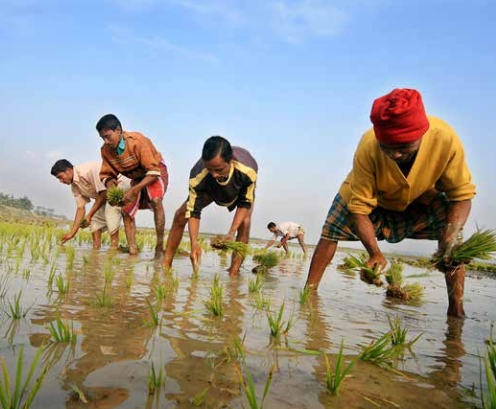By Jeff Smith
Bangladesh, one of the poorest countries in the world and subject to frequent flooding, can become food-secure, but will need to be much more efficient in using water to avoid putting pressure on groundwater resources, according to a new publication by the International Water Management Institute (IWMI).

Researchers projected that, given present trends, Bangladesh could produce rice surpluses of as much as 26% by 2030. However, such surpluses would be fuelled largely by high yield, irrigation-intensive rice, which is cultivated during the Boro season. Bangladesh already faces groundwater over-extraction and arsenic issues in parts of the northwest, north-central and southwest regions, partly because of the trend toward Boro rice farming.
IWMI researchers recommend that Bangladesh, which was rice self-sufficient in 2010, limits rice production to just what it needs to remain self-sufficient. “This scenario would require a smaller Boro rice area and, hence, lower irrigation,” said Upali Amarasinghe, Senior Researcher, IWMI, and lead author of the report.
[pullquote type=”pullquote1″ content=”This will reduce the pressure on the country’s scarce groundwater resources, and it’s the best way for Bangladesh to practice sustainable agricultural intensification.” quote_icon=”yes” align=”center” textcolor=”#211d1d”]This will reduce the pressure on the country’s scarce groundwater resources, and it’s the best way for Bangladesh to practice sustainable agricultural intensification.[/pullquote]
The IWMI study, which assessed the changing rice and other food consumption patterns in Bangladesh and its implications on water demand by 2030, was initiated as part of the CGIAR Challenge Program on Water and Food (CPWF) Ganges Basin Development Challenge. Modeling tools were used to analyze data between 1961 and 2012 to understand the changes in the recent past, and then extrapolate the trends under a ‘business as usual’ scenario.
Rice, which contributes to 72% of the total calorie supply from food, and approximately 80% of the total cropped and irrigated area in 2010, dominates food and water consumption in Bangladesh.
In fact, Bangladesh has one of the highest per capita rice consumption levels in the world, according to the Food and Agriculture Organization of the United Nations. This is partly due to the large number of people living in extreme poverty – 43% of the population. When income is low, people tend to consume more grains to meet daily calorie requirements. In Bangladesh, this happens to be rice, because it is the dominant crop. Thus, ensuring there is sufficient water for rice cultivation is critical.
Rice production has increased threefold since the early 1970s to support a growing population, with only an 18% increase in the rice area. Irrigation has been a major contributor to increases in yield and production, with groundwater contributing 88% to this increase. Irrigation demand would soar by another 50% by 2030 under a rice surplus ‘business as usual’ scenario.
IWMI researchers say that the demand for irrigation water can be reduced by improving water productivity, by targeting districts with high water use but lower rice yields. Restricting Boro rice farming only to achieve self-sufficiency willsave both land and irrigation water for increasing theproduction of other crops, such as vegetables, roots and tubers. This is important for nutritional security and dietary diversification associated with an increase in income, according to researchers.
While it is necessary to manage rice production, it won’t be sufficient to reduce the stress on groundwater resources of a country projected to grow in population from 145 million in 2008 to 182 million by 2030, according to the researchers. Groundwater also must meet domestic, industrial and environmental water needs.
IWMI and the CGIAR Research Program on Water, Land and Ecosystems (WLE), led by IWMI, are now conducting further research into assessing the potential of augmenting underground water storage by taking advantage of monsoon floodwaters, the costs and benefits of such schemes, and how such a program could be implemented.
Read the report:
Amarasinghe, U. A.; Sharma, B. R.; Muthuwatta, L.; Khan, Z. H. 2014. Water for food in Bangladesh: outlook to 2030. Colombo, Sri Lanka: International Water Management Institute (IWMI). 32p. (IWMI Research Report 158).
[hr top=”yes”/]
Upali A. Amarasinghe is a Senior Researcher at the International Water Management Institute
(IWMI), Hyderabad, India.

